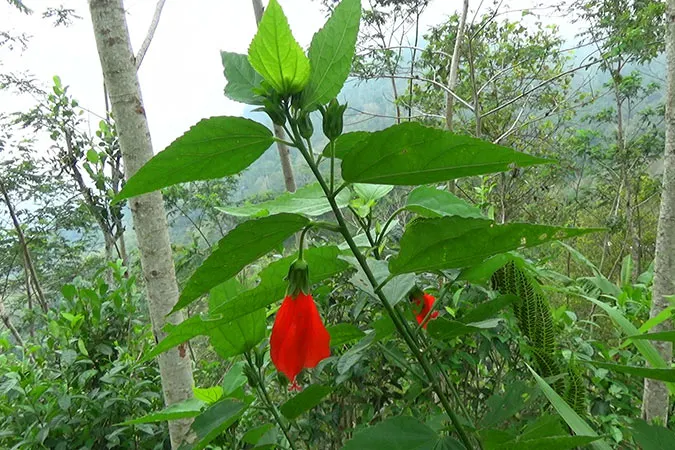Kembang payung or sleeping hibiscus (Malvaviscus penduliflorus) is a plant species in Malvaceae, shrubs up to 4 m high, hard woody stems with brown bark and green young branches, hairy or hairless branchlets, stipules shaped like threads for 4 mm and drooping down.
M. penduliflorus has a leaf stalk for a length of 1-2 cm and hair, leaves are ovoid to pointy, 6-12 cm long and 2.5-6 cm wide, a wedge-shaped base wide to almost rounded and a pointed tip, serrated edge, colored upper surface dark green and shiny, the lower surface is brighter and both surfaces are hairless.
Solitary flowers, hanging from axils on the stem 1.5 cm long, red, tubular and 5 cm long. Has 8 fake sepals, spoon-shaped, 1-1.5 cm and ciliate margins. The sepal cup is slightly longer than the epicalyx and has long hair, a 7 cm long column of stamens protruding from the flower.
Sleeping hibiscus are always green, very rare to bear fruit, grow to an altitude of 1000 m, lots of sunlight in open forests, road sides and untreated areas. Many are cultivated for ornamental plants in the yard of the house and open places.
Kingdom: Plantae
Phylum: Tracheophyta
Subphylum: Angiospermae
Class: Magnoliopsida
Order: Malvales
Family: Malvaceae
Subfamily: Malvoideae
Tribe: Hibisceae
Genus: Malvaviscus
Species: Malvaviscus penduliflorus
M. penduliflorus has a leaf stalk for a length of 1-2 cm and hair, leaves are ovoid to pointy, 6-12 cm long and 2.5-6 cm wide, a wedge-shaped base wide to almost rounded and a pointed tip, serrated edge, colored upper surface dark green and shiny, the lower surface is brighter and both surfaces are hairless.
Solitary flowers, hanging from axils on the stem 1.5 cm long, red, tubular and 5 cm long. Has 8 fake sepals, spoon-shaped, 1-1.5 cm and ciliate margins. The sepal cup is slightly longer than the epicalyx and has long hair, a 7 cm long column of stamens protruding from the flower.
Sleeping hibiscus are always green, very rare to bear fruit, grow to an altitude of 1000 m, lots of sunlight in open forests, road sides and untreated areas. Many are cultivated for ornamental plants in the yard of the house and open places.
Kingdom: Plantae
Phylum: Tracheophyta
Subphylum: Angiospermae
Class: Magnoliopsida
Order: Malvales
Family: Malvaceae
Subfamily: Malvoideae
Tribe: Hibisceae
Genus: Malvaviscus
Species: Malvaviscus penduliflorus
